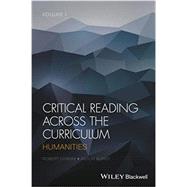Powerful strategies, tools, and techniques for educators teaching students critical reading skills in the humanities.
Every educator understands the importance of teaching students how to read critically. Even the best teachers, however, find it challenging to translate their own learned critical reading practices into explicit strategies for their students. Critical Reading Across the Curriculum: Humanities, Volume 1 presents exceptional insight into what educators require to facilitate critical and creative thinking skills.
Written by scholar-educators from across the humanities, each of the thirteen essays in this volume describes strategies educators have successfully executed to develop critical reading skills in students studying the humanities. These include ways to help students:
- focus
- actively re-read and reflect, to re-think, and re-consider
- understand the close relationship between reading and writing
- become cognizant of the critical importance of context in critical reading and of making contextual connections
- learn to ask the right questions in critical reading and reasoning
- appreciate reading as dialogue, debate, and engaged conversation
In addition, teachers will find an abundance of innovative exercises and activities encouraging students to practice their critical reading skills. These can easily be adapted for and applied across many disciplines and course curricula in the humanities.
The lifelong benefits of strong critical reading skills are undeniable. Students with properly developed critical reading skills are confident learners with an enriched understanding of the world around them. They advance academically and are prepared for college success. This book arms educators (librarians, high school teachers, university lecturers, and beyond) with the tools to teach a most paramount lesson.








